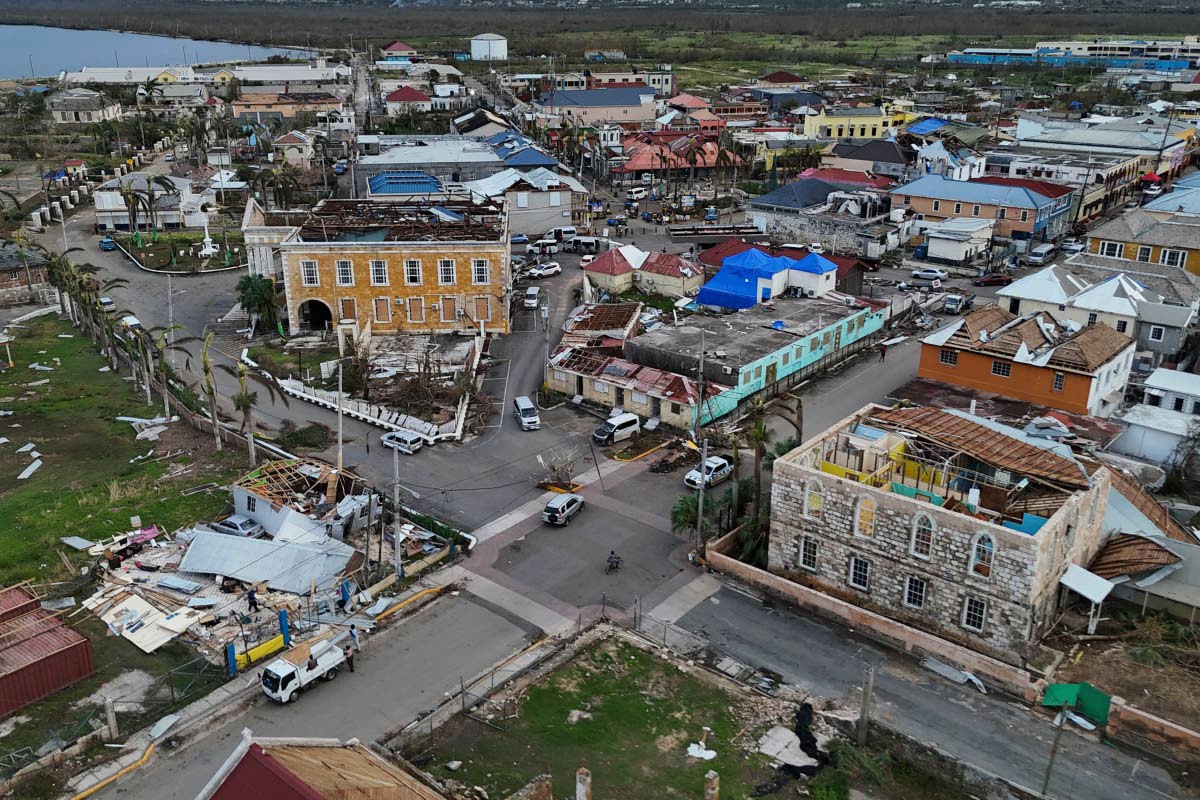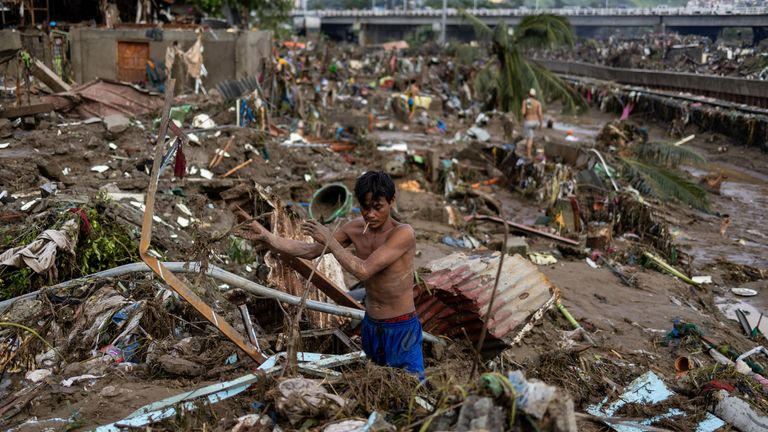Typhoon Kalmaegi, one of the most powerful storms to hit Asia this year, wreaked havoc across Vietnam and the Philippines, leaving a trail of destruction and claiming at least 114 lives. The typhoon made landfall in Vietnam on November 6, with winds reaching up to 92 mph (149 km/h), forcing the closure of six airports and disrupting hundreds of flights. The Vietnamese government has mobilized over 260,000 soldiers and 6,700 vehicles, including six aircraft, for rescue and relief operations. The storm has already caused widespread damage, including flooded homes, uprooted trees, and shattered infrastructure in provinces like Dak Lak and Gia Lai. Local media reported that hundreds of residents in Dak Lak province called for emergency assistance as their homes collapsed or were inundated by floodwaters. Vietnam’s weather bureau warned of potential waves up to 8 meters (26 feet) in the South China Sea, posing a significant threat to coastal communities. Prime Minister Pham Minh Chinh emphasized the urgency of reaching isolated areas to ensure access to food, water, and essential supplies. Meanwhile, the Philippines faced catastrophic flooding, particularly in central regions like Cebu, where entire neighborhoods were wiped out. President Ferdinand Marcos Jr. declared a state of emergency as survivors began the arduous task of cleaning up and rebuilding. The typhoon’s impact extended beyond Vietnam and the Philippines, with Thailand also bracing for flash floods and landslides. The storm serves as a stark reminder of the increasing intensity of weather events in the region, prompting calls for heightened preparedness and resilience.
分类: world
-

Wat u moet weten over COP30, de VN-klimaatconferentie van dit jaar
World leaders, activists, experts, and delegates from across the globe have converged in Belem, Brazil, for the 30th United Nations Climate Change Conference, known as COP30. Nestled at the gateway to the Amazon rainforest, Belem serves as a symbolic backdrop for discussions aimed at addressing the escalating impacts of human-induced climate change. The primary goal of the summit is to foster international collaboration to mitigate the worst effects of global warming, though many experts warn that time is running out to achieve meaningful progress. Climate change is already triggering life-threatening disasters worldwide, and delaying action will only exacerbate the crisis. This year’s conference emphasizes the critical role of indigenous communities, sustainable land management, and the preservation of vital ecosystems like the Amazon rainforest, often referred to as the ‘lungs of the Earth.’ Brazil has introduced the Tropical Forests Forever Facility, a financial incentive program to protect forests, though its success hinges on sufficient funding from global leaders. Logistical challenges, including housing thousands of attendees in a city with limited infrastructure, have added complexity to the event. Despite these hurdles, the Brazilian government insists on hosting the summit in Belem to highlight the vulnerability of poorer communities to climate-induced disasters. A decade after the landmark Paris Agreement, global temperatures have risen by approximately 0.46 degrees Celsius, pushing the world closer to breaching the 1.5-degree threshold. While renewable energy has become more affordable than fossil fuels, many nations, including the United States, have failed to submit updated climate action plans. Experts criticize the lack of ambition in existing commitments, warning that current efforts fall short of what is needed to avert catastrophic outcomes. Unlike previous COP summits, COP30 is not expected to yield a groundbreaking agreement but is instead framed as an ‘implementation COP,’ focusing on translating existing pledges into actionable measures. However, skepticism remains, with some officials, like Panama’s Environment Minister Juan Carlos Navarro, dismissing such gatherings as bureaucratic exercises with minimal impact. As the world watches, the stakes for COP30 could not be higher, with the future of the planet hanging in the balance.
-

Cibao Airport is experiencing delays to and from the United States due to air traffic controllers
Cibao International Airport in Santiago, Dominican Republic, has been grappling with a wave of flight delays and cancellations since Friday, primarily affecting routes to and from the United States. This disruption is part of a broader aviation crisis in the U.S., triggered by a severe shortage of air traffic controllers. Over the past 24 hours, the Santiago terminal has joined numerous airports across the continent experiencing operational chaos, leaving hundreds of passengers stranded and creating scenes of frustration and uncertainty. According to a spokesperson from Cibao International Airport’s communications department, at least seven scheduled flights to or from major U.S. cities such as New York, Boston, and San Juan have been rescheduled. These flights, primarily operated by JetBlue Airways and United Airlines, include JetBlue 837 from New York, rescheduled from 8:34 p.m. to 11:20 p.m., and JetBlue 337, also from New York, moved from 11:12 p.m. to 11:39 p.m. Other affected flights include JetBlue 2137 from New York, delayed from 3:33 p.m. to 4:46 p.m., and United 1624 from Newark, postponed from 2:53 p.m. to 5:33 p.m. JetBlue 2723 from Boston was also delayed from 5:43 p.m. to 6:00 p.m. Notably, JetBlue 1607 from San Juan maintained its scheduled departure at 4:15 p.m., standing out as one of the few unaffected flights. The root of this crisis lies in the partial shutdown of the U.S. federal government, which has left thousands of Federal Aviation Administration (FAA) employees unable to work due to the lack of a budget extension. While international flights, including those connecting Santiago with U.S. cities, are not the most directly impacted, the uncertainty continues to unsettle travelers and airport operators. Cibao International Airport, a key hub for international connections in the Dominican Republic, remains on high alert as the situation unfolds.
-

Tornado Kills Six, Injures Hundreds in Brazil
A catastrophic tornado tore through the southern Brazilian state of Paraná on Friday night, leaving a trail of devastation in its wake. The storm, with wind speeds exceeding 155 miles per hour, claimed the lives of at least six individuals, including a 14-year-old girl, and injured over 750 people. One person remains unaccounted for, and the number of displaced families continues to escalate. The city of Rio Bonito do Iguaçu bore the brunt of the disaster, with civil defense officials estimating that 90% of the area sustained significant damage. Local resident Roselei Dalcandon, standing amidst the ruins of her former shop, lamented, ‘It destroyed everything—the town, houses, and schools. What will become of us?’ Brazilian President Luiz Inácio Lula da Silva expressed solidarity with the victims on social media, while his Cabinet announced the deployment of emergency aid to the affected regions. The tragedy coincides with Brazil hosting COP30 in Belém, where global leaders are convening to discuss climate resilience. The storm’s ferocity underscores the urgent need for enhanced disaster preparedness, climate finance, and early-warning systems, particularly for vulnerable nations grappling with the escalating impacts of climate change.
-

T&TEC, TTDF to send relief teams to Jamaica
In response to the catastrophic impact of Hurricane Melissa, the Trinidad and Tobago Electricity Commission (T&TEC) has announced the deployment of a specialized team to Jamaica. According to a media release issued on November 8, the team will focus on restoring electricity in the most severely affected regions. The send-off ceremony for the team is scheduled for November 10, with Minister of Public Utilities Barry Padarath, Minister in the Ministry of Public Utilities Clyde Elder, and Parliamentary Secretary Shivanna Sam in attendance. Additionally, a contingent of 20 soldiers from Trinidad and Tobago will be dispatched to Jamaica in the coming days to assist in relief efforts. Hurricane Melissa, which made landfall in Jamaica as a Category 5 storm on October 28, caused widespread devastation across several parishes, including St Elizabeth, Westmoreland, Hanover, Manchester, St James, Trelawny, and St Ann. The hurricane resulted in 32 fatalities in Jamaica and 43 in neighboring Haiti, along with millions in damages. The Trinidad and Tobago government, in collaboration with civil society and private sector organizations, has already sent multiple shipping containers of essential supplies, including food and construction tools, to aid in recovery efforts. An inter-ministerial committee has also been established to coordinate national relief initiatives.
-

Tobago’s illusion of amelioration
Between 1823 and 1833, escalating tensions between Caribbean planters and enslaved workers reached a critical point, threatening the region’s socio-economic stability. Enslaved populations, increasingly intolerant of their subjugation, launched widespread resistance movements that challenged the very foundations of the plantation system. Fearing the potential for uncontrollable chaos, the West Indian lobby urged the British Parliament to implement reforms aimed at improving the living and working conditions of enslaved Africans. These proposals included measures such as limiting physical punishments, encouraging slave marriages, and allowing enslaved individuals to own property and purchase their freedom. However, these reforms, which aimed to mitigate the harsh realities of enslavement, were met with fierce opposition from the plantocracy. Planters in Tobago, in particular, resisted these changes, viewing them as threats to their control over the enslaved population and their economic interests. Despite efforts to portray the era as one of ‘amelioration,’ the revised laws largely preserved the oppressive structures of slavery, with new courts established to enforce harsh penalties for resistance. The Anglican Church, initially aloof, later joined efforts to Christianize the enslaved population, seeing it as a means of control. Ultimately, the planters’ rejection of these reforms led to the British Parliament’s decision to abolish slavery in its colonies in 1833, marking the end of a tumultuous decade of resistance and reform.




